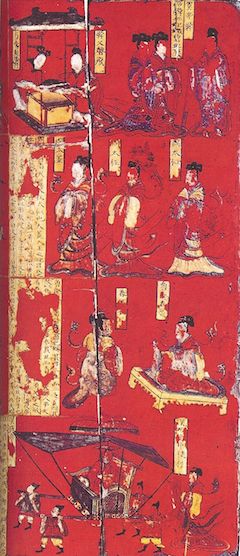Lacquer Screen with Figure Story Paintings from Sima Jinlong Tomb
Name: Lacquer screen with color figure paintings | 中文名: 彩绘人物故事漆屏
Dated to: 419-484 A.D. | Culture: Northern Wei Dynasty
Unearthed: 1965@Datong, Shanxi | Current location: Datong Museum
Dimensions: 80 x 20 x 2.5cm
Sima Jinlong Tomb
According to Book of Wei, Sima Jinlong is the ninth generation grandson of Lord Sima Kui (Brother of Emperor Xuan (Sima Yi) of Jin). Sima Jinglong and his wife Ji Cheng were buried together in this tomb.
This Sima Jinlong’s tomb has been robbed before, but there are still quite a lot of relics unearthed. When this lacquer screen was unearthed, there are five better preserved pieces. Originally, there should be paintings on both sides. The down side was seriously corroded and hard to distinguish, the up side is well preserved. There are four pieces of carved stone screen stands unearthed at the same time. The decorations on the stands are delicate too, but mostly are Buddhism topics, which are unrelated to the screen paintings.
Formation and Content
It was made of wood after finishing with red lacquer. The figures were outlined with black ink, their faces and hands were painted with lead white, clothes and things were presented with various colors such yellowish white, blueish green, orange, and grayish blue, etc. There are also notes written with black ink on yellow background.
The painting topics at that time could be divided into three categories: one is classic stories, second is folk realistic stories, and the third is mythology stories. Royal and noble families specially emphasize on classic stories in order to educate and civilize people. So most of figure paintings in these families have such content. Screens are also a great platform for such stories. This lacquer painting is a typical example, showing most stories about exemplar women.
The complete images of this painting are still not published. The picture on the right shows one side of first and second blocks. The painting was divided into four sections:
The top section has five figures, including Emperor Shun‘s father Gu Sou, Shun’s Wives E-Huang and Nu-Ying, and Shun himself. It tells Shun’s story of abiding filial piety.
The second section has three figures – Three Queens of Zhou Dynasty, including King Tai’s Wife Tai-Jiang, King Wen (Ji Chang)‘s mother Tai-Ren and King Wu (Ji Fa)‘s mother Tai-Shi. They are the traditional high virtue exemplars of mothers and wives.
The third section has two figures. They are Lushi Chunjiang and Chunjiang’s daughter.
The bottom section has six figures, showing Consort Ban declined an Emperor’s invitation to ride in a palanquin because she feared to distract him from matters of state. In the painting, Emperor Cheng of Han was sitting in the big palanquin with a tall tent, looking backward. Four servants was holding the palanquin, while Consort Ban was following them on foot.
All these stories were take from Lienu Zhuang (Biographies of Exemplary Women) compiled by the famous scholar Liu Xiang. It includes 125 biographical accounts of women exemplars in early China, taken from Chinese histories like the Chun Qiu, Zuo Zhuan, and Shiji. The Lienü Zhuan served as a standard Confucianist textbook for the moral education of women in traditional China for two millennia.
Artistic Value
The stories presented on this lacquer screen inherited the tradition since Han Dynasty to use historical stories to educate people. Some of its notes were directly quoted from historical texts. Its calligraphy styling was also influenced by the scholars since East Jin Dynasty.
The expressions and gestures of the figures in the painting is quite similar to Kaizhi Gu’s (a famous painter of East Jin) work. Gu lived decades earlier than this paining, so it suggests his style and techniques had been adapted after his death and at least inherited on until Southern and Northern Dynasties. The brief peaceful time during Taihe Era provided a convenience for cultural exchange between the south and north.
[Forbidden Treasure of China Series]
This is the 22nd of 64 culture heritages that the government of China forbids to exhibit abroad. The complete list is here. In Chinese.
[Chinese Keywords]
国家一级文物 禁止出境





